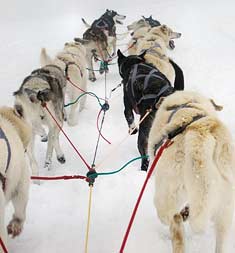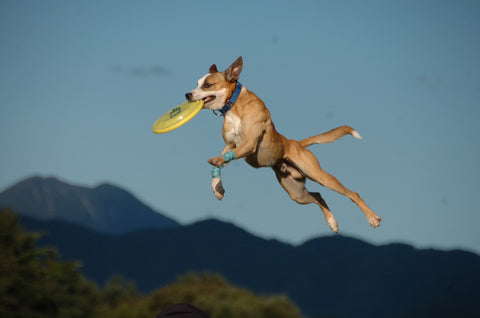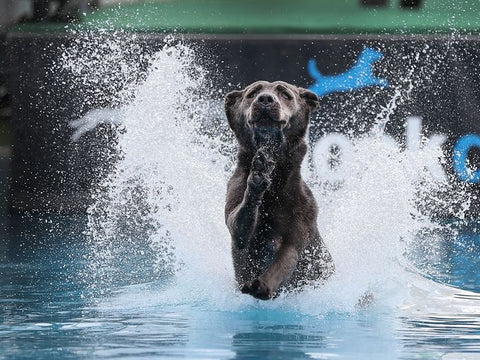What makes an active dog food work?
Posted on
What makes a food appropriate for an active dog? Here are some
parameters we go by:
~Highly digestible ingredients; we want to maximize digestibility so
all the ingredients are "useable" by the dog. These guys are really
pushing the calories and have limited space for those calories (their
stomachs are only so big) and a limited amount they can eat each day,
so every little bit counts. Think of the diet of a dog as an orchestra
of 100 seats. You want every seat in that orchestra to play a useful
role and play "in concert" with the rest of the orchestra to get the
full effect of what you paid for; we need to maximize those seats with
ingredients that help promote activity. If it cannot play a useful
role, what is the point? That is, if it is not digestible, there is no
point of having it there in the first place, taking up space in an
efficient, powerful orchestra.

~Fiber composition to allow for controlled digestion. Wiith activity,
everything tends to speed up, including the transit time of ingesta
(food) through the gastrointestinal tract. Certain fiber types will
slow down the transit time along the way, and also allow the colon to
do its job, which is to extract water and form a solid stool . The
key point to remember here is that the colon is important in the
scheme of successful overall digestion; more to come on that later,
but for now, think pretty poop.
~Fat content of the food should be higher. Not only does the overall
amount of fat need to be higher to concentrate available energy in a
smaller space (the kibble), but the types of fat are important as
well. Certain types are digested quicker than others, for instance.
Also, a higher inclusion of fat in the diet can actually increase a
dog's V02 max (the measure of how efficiently they use oxygen). This
is one reason a dog should be kept on the higher fat diet year-round,
even though the dog trains for seasonal exercise (like a field trial
dog) so this type of metabolic process is primed for their seasonal
exercise and training. The dog is meant to be fueled on fat; their
body is made for it. Dogs are not little people, so let's not feed
them that way.

~High levels of omega 3 fatty acids from marine sources. Marine
sourced omega 3 fatty acids are different than a land based omega 3
fatty acids, as marine sourced omegas exert much more activity in the
anti-inflammatory cascade than a land based omega 3 (such as one
derived from pea protein). Decreasing the inflammation associated
with activity is something we want, especially in the act of recovery
from a sporting event, to name just one important element that is
impacted by the sourcing of the omegas.
~Animal based proteins are the primary protein type. Dogs thrive on
proteins from another animal, not proteins from a plant. An
animal-rich protein based diet satisfies that need and also works to
properly balance all the amino acids the dogs need. A variety of
protein sources from animals (chicken, fish, egg, etc.) does just
that.

~Palatable. When a working dog is working, often they get tired and
don't want to eat much. When that happens, it affects many things,
including compromising the recovery of the dog so they're ready for
the next day's activities. The timing of feeding, in an effort to
keep or replenish the glycogen stores in the dogs body, are also a
major part of the puzzle here.

~Energy dense . Working dogs go through a lot of calories in their
pursuit of athletic performance. Field trial dogs may go through
3,000 calories a day while a sled dog could go through 12-14,000
calories (like 18 Big Macs!) The dog's stomach can handle only so much
volume, so the food needs to be energy dense - and that typically
means a high fat food, as fat is what used for energy, not protein or
carbohydrates. Fat brings twice as much energy to the plate as a
carbohydrate or protein, so that reduces the volume needing to be fed.
Calorically dense fat makes sense overall in the digestion scheme of a
working dog, as higher amounts of nutrients, like carbs, require more
time to digest; a busy dog has already accelerated their
gastrointestinal transit time by being active, and slower digesting
carbs just aren't handy or efficient. Lastly, fat makes everything
taste delicious in a dog's world, so it helps in getting a tired dog
to eat.
~Lower carbohydrate level. This is about bulk and whether dogs really can use carbs offered in kibble efficiently when active. Carbohydrates take up twice as much space
overall than fat, in terms of equalizing out the calories they bring.
One gram of carbohydrate gives about 4 calories, while one gram of fat
brings about nine calories, so you need twice the volume of carbs to
get the same amount of calories as fat. Carbohydrates take more
time to digest than fat, and they also need to be cooked properly in the
process of making a kibble. Carbohydrates are actually included in a
kibble to keep all the nutrients stuck together; they bind stuff
together. Often in the process of making a kibble diet, the
carbohydrates are not completely converted to a nutrient that can be
digested by the dog; sometimes as much as 20% of the carbs are not
cooked completely. A good example of this situation is rice; you need
to boil it for 20 minutes, or some of it just will pass through the
gastrointestinal transit, looking exactly the same coming out as when
it went in, if you know what I mean. In a highly active dog, or any
dog for that matter, these partially cooked carbohydrates will zip
through the dog undigested and then reach the colon. There, the
partially cooked carbs will attract water, and lead to soft or watery
stools. This is called osmotic diarrhea. This is a big reason why
certain foods just don't work in an athletic dog.
parameters we go by:
~Highly digestible ingredients; we want to maximize digestibility so
all the ingredients are "useable" by the dog. These guys are really
pushing the calories and have limited space for those calories (their
stomachs are only so big) and a limited amount they can eat each day,
so every little bit counts. Think of the diet of a dog as an orchestra
of 100 seats. You want every seat in that orchestra to play a useful
role and play "in concert" with the rest of the orchestra to get the
full effect of what you paid for; we need to maximize those seats with
ingredients that help promote activity. If it cannot play a useful
role, what is the point? That is, if it is not digestible, there is no
point of having it there in the first place, taking up space in an
efficient, powerful orchestra.

~Fiber composition to allow for controlled digestion. Wiith activity,
everything tends to speed up, including the transit time of ingesta
(food) through the gastrointestinal tract. Certain fiber types will
slow down the transit time along the way, and also allow the colon to
do its job, which is to extract water and form a solid stool . The
key point to remember here is that the colon is important in the
scheme of successful overall digestion; more to come on that later,
but for now, think pretty poop.
~Fat content of the food should be higher. Not only does the overall
amount of fat need to be higher to concentrate available energy in a
smaller space (the kibble), but the types of fat are important as
well. Certain types are digested quicker than others, for instance.
Also, a higher inclusion of fat in the diet can actually increase a
dog's V02 max (the measure of how efficiently they use oxygen). This
is one reason a dog should be kept on the higher fat diet year-round,
even though the dog trains for seasonal exercise (like a field trial
dog) so this type of metabolic process is primed for their seasonal
exercise and training. The dog is meant to be fueled on fat; their
body is made for it. Dogs are not little people, so let's not feed
them that way.

~High levels of omega 3 fatty acids from marine sources. Marine
sourced omega 3 fatty acids are different than a land based omega 3
fatty acids, as marine sourced omegas exert much more activity in the
anti-inflammatory cascade than a land based omega 3 (such as one
derived from pea protein). Decreasing the inflammation associated
with activity is something we want, especially in the act of recovery
from a sporting event, to name just one important element that is
impacted by the sourcing of the omegas.
~Animal based proteins are the primary protein type. Dogs thrive on
proteins from another animal, not proteins from a plant. An
animal-rich protein based diet satisfies that need and also works to
properly balance all the amino acids the dogs need. A variety of
protein sources from animals (chicken, fish, egg, etc.) does just
that.

~Palatable. When a working dog is working, often they get tired and
don't want to eat much. When that happens, it affects many things,
including compromising the recovery of the dog so they're ready for
the next day's activities. The timing of feeding, in an effort to
keep or replenish the glycogen stores in the dogs body, are also a
major part of the puzzle here.

~Energy dense . Working dogs go through a lot of calories in their
pursuit of athletic performance. Field trial dogs may go through
3,000 calories a day while a sled dog could go through 12-14,000
calories (like 18 Big Macs!) The dog's stomach can handle only so much
volume, so the food needs to be energy dense - and that typically
means a high fat food, as fat is what used for energy, not protein or
carbohydrates. Fat brings twice as much energy to the plate as a
carbohydrate or protein, so that reduces the volume needing to be fed.
Calorically dense fat makes sense overall in the digestion scheme of a
working dog, as higher amounts of nutrients, like carbs, require more
time to digest; a busy dog has already accelerated their
gastrointestinal transit time by being active, and slower digesting
carbs just aren't handy or efficient. Lastly, fat makes everything
taste delicious in a dog's world, so it helps in getting a tired dog
to eat.
~Lower carbohydrate level. This is about bulk and whether dogs really can use carbs offered in kibble efficiently when active. Carbohydrates take up twice as much space
overall than fat, in terms of equalizing out the calories they bring.
One gram of carbohydrate gives about 4 calories, while one gram of fat
brings about nine calories, so you need twice the volume of carbs to
get the same amount of calories as fat. Carbohydrates take more
time to digest than fat, and they also need to be cooked properly in the
process of making a kibble. Carbohydrates are actually included in a
kibble to keep all the nutrients stuck together; they bind stuff
together. Often in the process of making a kibble diet, the
carbohydrates are not completely converted to a nutrient that can be
digested by the dog; sometimes as much as 20% of the carbs are not
cooked completely. A good example of this situation is rice; you need
to boil it for 20 minutes, or some of it just will pass through the
gastrointestinal transit, looking exactly the same coming out as when
it went in, if you know what I mean. In a highly active dog, or any
dog for that matter, these partially cooked carbohydrates will zip
through the dog undigested and then reach the colon. There, the
partially cooked carbs will attract water, and lead to soft or watery
stools. This is called osmotic diarrhea. This is a big reason why
certain foods just don't work in an athletic dog.

So, when choosing a food for a dog that is active you should look for a formula that is made for that purpose. there are many good foods out there but not necessarily meant for every lifestyle a dog made be encountering. A working dog needs a working dog food, using a food intended for something else is like putting a round peg in a square hole. Ultimately to judge if the food is working to its potential look at the dogs actual performance, its muscle tone, its recovery, appetite when under stress and the poop. The dogs' stool before, during and after the exercise-it tells a pretty good story of how digestion is happening.